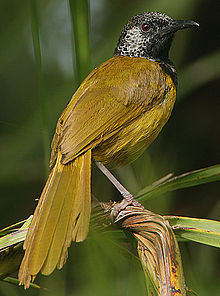Oriole warbler
| Oriole warbler | |
|---|---|

| |
| Scientific classification | |
| Domain: | Eukaryota |
| Kingdom: | Animalia |
| Phylum: | Chordata |
| Class: | Aves |
| Order: | Passeriformes |
| Family: | Cisticolidae |
| Genus: | Hypergerus Reichenbach, 1850 |
| Species: | H. atriceps
|
| Binomial name | |
| Hypergerus atriceps (Lesson, 1831)
| |
The oriole warbler (Hypergerus atriceps) is a large warbler in the family Cisticolidae, and the only member of the genus Hypergerus. This bird is a resident breeder in west Africa from southern Senegal to Cameroon.
This skulking passerine is typically found in dense thickets usually near water. The oriole warbler builds a large untidy nest suspended from palm leaves.
These 20-cm long warblers have a long tail, strong legs and a long black bill. At a weight of around 30 g (1.1 oz) the oriole warbler may be the largest of the species-rich Cisticolidae family.[2] Adults are light olive above, yellow below and have a black hood. The species' name refers to their resemblance to the unrelated but similarly black and yellow orioles. The sexes are similar, but juveniles are duller.
Like most warblers, the oriole warbler is insectivorous. The song is a loud whistled duetted toooo-ooo-eee-oooo, oooo-ooo-eee-oooo. The male always leads the duet[3] and the female answers, though this is done in a manner that is temporally rather loose.[4]
References[edit]
- ^ BirdLife International (2016). "Hypergerus atriceps". IUCN Red List of Threatened Species. 2016: e.T22713842A94391340. doi:10.2305/IUCN.UK.2016-3.RLTS.T22713842A94391340.en. Retrieved 12 November 2021.
- ^ Dunning, John B. Jr., ed. (2008). CRC Handbook of Avian Body Masses (2nd ed.). CRC Press. ISBN 978-1-4200-6444-5.
- ^ Slater, P.J.B.; Gil, Diego; Barlow, Clive R. and Graves, J.A.; ”Male-led duets in the Moho, Hypergerus atriceps, and Yellow-crowned Gonolek, Laniarius barbarus”; in Ostrich: Journal of African Ornithology Volume 73, Issue 1-2, 2002 pp. 49-51
- ^ Brumm, Henrik and Slater, Peter; “Animal Communication: Timing Counts” in Current Biology Volume 17, Issue 13, 3 July 2007, pp. R521–R523
- Birds of The Gambia by Barlow, Wacher and Disley, ISBN 1-873403-32-1
- Ryan, Peter (2006). Family Cisticolidae (Cisticolas and allies). pp. 378–492 in del Hoyo J., Elliott A. & Christie D.A. (2006) Handbook of the Birds of the World. Volume 11. Old World Flycatchers to Old World Warblers Lynx Edicions, Barcelona ISBN 978-84-96553-06-4
- Nguembock B.; Fjeldsa J.; Tillier A.; Pasquet E. (2007): A phylogeny for the Cisticolidae (Aves: Passeriformes) based on nuclear and mitochondrial DNA sequence data, and a re-interpretation of a unique nest-building specialization. Molecular Phylogenetics and Evolution 42: 272–286.

